Onion cultivation in India ranks second in the world. Onions from India are known for their acuteness and are available throughout the year. There are two crop cycles for Indian onions; the first runs from November to January, and the second from January to May. Onions are hardy cool-season biennials but are mostly grown as annual crops. Its leaves are narrow and hollow, and its base enlarges to form a bulb.
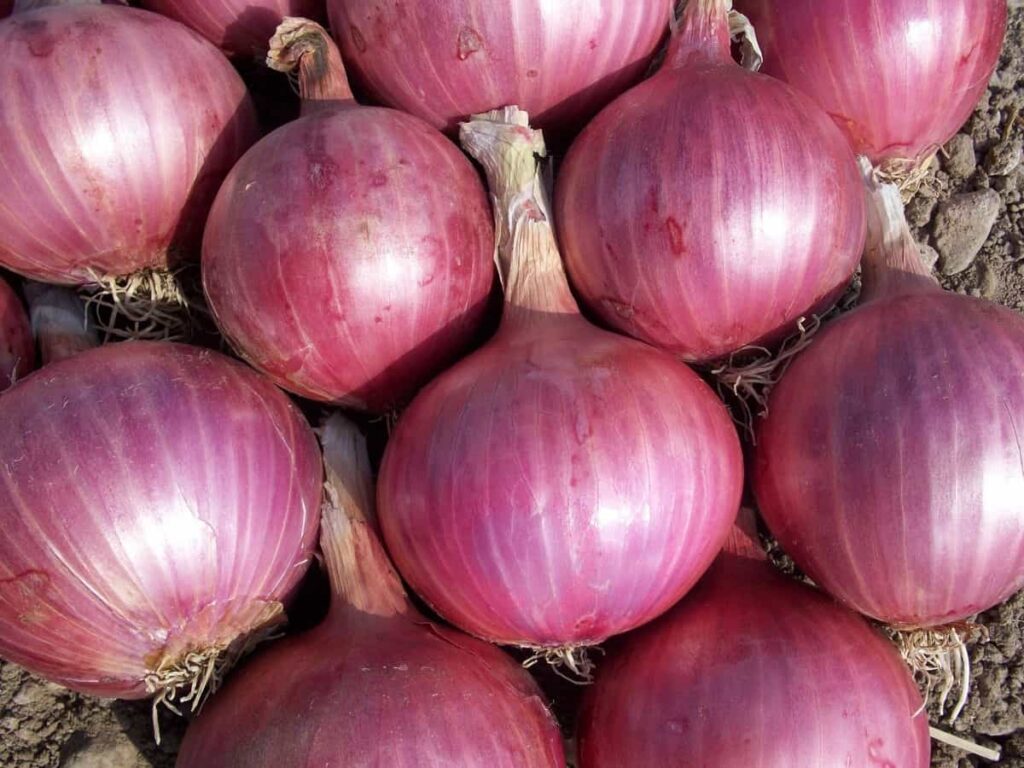
Harvesting of the bulb can take between 80 and 150 days, depending on the color. Onion production occurs primarily in Maharashtra, Madhya Pradesh, Karnataka, Gujarat, Rajasthan, Bihar, Andhra Pradesh, Haryana, West Bengal, Uttar Pradesh, Chhattisgarh, Odisha, Tamil Nadu, Jharkhand, and Telangana in India.
Hybrid high yield Onions varieties in India
Climate and soil required for Onion farming
In addition to being a temperate crop, onion can also be grown in tropical, subtropical, and temperate climates. The best performance can be obtained in mild weather without extremes of cold, heat, and excessive rainfall. Although the onion plant is hardy, it can withstand freezing temperatures when young. It requires 10-12 hours of daylight to grow short-day onions in the plains in India.
The optimal temperature for vegetative growth and bulb development is 13 C to 24 C and 16 C to 25 C, respectively. For good growth, it needs about 70% relative humidity. When the monsoon season begins, it grows well in places with an average annual rainfall of 650 to 750 mm. Various soil types can be used to grow onions, including sandy loams, clay loams, silt loams, and heavy soils.
Onions grow best in deep, friable loams and alluvial soils with good drainage, moisture-holding capacity, and sufficient organic matter. The bulbs produced by heavy soils may be deformed. Applying organic manure before planting can help onion crops grow successfully on heavy soils, and the field preparation for onion cultivation should be excellent. A pH range of 6.0 to 7.5 is ideal for growing onions, regardless of soil type. Onions can also be grown in mildly alkaline soils.
Onion varieties
A. Red Onion varieties
Bhima Super
The Directorate of Onion & Garlic Research has identified a red onion variety for release in Chhattisgarh, Delhi, Gujarat, Haryana, Karnataka, Madhya Pradesh, Maharashtra, Odisha, Punjab, Rajasthan, and Tamil Nadu for the Kharif season. Late Kharif is also suitable for growing it. According to reports, it yields 20 to 22 tons per hectare in Kharif and 40 to 45 tons per hectare in late Kharif. It takes 100 to 105 days for bulbs to reach maturity after transplanting in Kharif and 110 to 120 days to reach maturity in late Kharif. Mostly single-centered bulbs are produced.
In case you missed it: White Onion Farming in India: Grow Onions Bigger, Faster and Onion Growing Duration
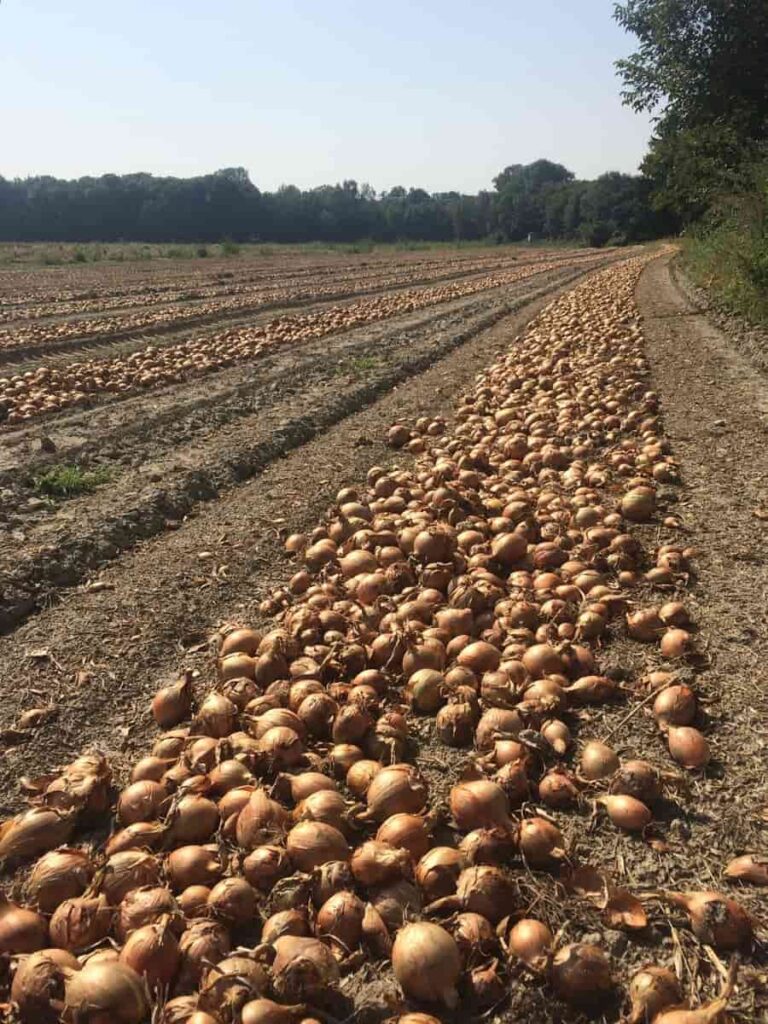
Bhima Red
This variety is recommended for rabi season in Maharashtra and Madhya Pradesh, and in Delhi, Gujarat, Haryana, Karnataka, Maharashtra, Punjab, Rajasthan, and Tamil Nadu, it is recommended for Kharif season. Late Kharif is also an excellent time to grow it. The bulbs are red and round. After transplanting during Kharif, plants mature in 105 to 110 days, and during Rabi, they mature in 110 to 120 days.
Kharif produces an average marketable yield of 19 to 21 tons per hectare. In the late Kharif season, the yield is 48 to 52 tons per hectare, while in the rabi season, it is 30 to 32 tons per hectare. Possible to store these onions for up to three to four months during the Rabi season. Since this variety can be stored for up to 3 months during Rabi, it can also be grown during the Rabi season for direct marketing.
hima Raj
A single center and thin neck are characteristic of Bhima Raj bulbs, which are dark red and oval. Maharashtra, Karnataka, and Gujarat states can grow this variety in Kharif and late Kharif seasons. During Rabi, the Bhima Raj matures within 120 to 125 days after transplanting without bolters, with an average yield of 25 to 30 tons per hectare and a high percentage of marketable bulbs. In terms of yield potential, there are a 40 to 45 tons per hectare range.
Bhima Dark Red
According to the Directorate of Onion & Garlic Research, this onion variety will be released in Chhattisgarh, Delhi, Gujarat, Haryana, Karnataka, Madhya Pradesh, Maharashtra, Odisha, Punjab, Rajasthan, and Tamil Nadu for the Kharif season. Approximately 20 to 22 tons of marketable crops can be produced per hectare. This bulb is recommended primarily because of its attractive dark red flat globe. Within 95 to 100 days of transplantation, it reaches maturity.
Bhima Shakthi
A red onion variety has been identified for the late Kharif and Rabi season in Maharashtra, Karnataka, Andhra Pradesh, Delhi, UP, Haryana, Bihar, Punjab, Rajasthan, Gujarat, MP, Chhattisgarh, and Orissa. During the late Kharif and Rabi seasons, bulbs mature 130 days after transplanting. There is a marketable yield of 46 tons per hectare during late Kharif and 43 tons per hectare during Rabi. In terms of storage, the variety has a better shelf life of five to six months.
Punjab selection
Punjab Agricultural University, Ludhiana, has released this onion variety. Approximately 5 to 6 cm in diameter, the bulbs are red, spherical, and shaped like an egg. The average onion weighs between 50 and 70 grams. The bulbs are pretty firm and have good keeping qualities. The total soluble solids are approximately 14%. This onion variety has an average yield of 20 tons per hectare. For Rabi season, it is recommended.
Pusa Red
Onion bulbs of this type are medium in size, purple-red, and flattish round. A bulb weighs 70 to 90 grams, has less bolting, and has poor pungency. Short to intermediate day lengths are required for this variety. The plant matures between 123 and 140 days after transplanting. This high-yielding variety produces approximately 25 to 30 tons of produce per hectare. The bulb measures about 6 cm long by 6.5 cm wide.
In case you missed it: Onion Farming in Tamilnadu: A Helpful Production Guide for Beginners
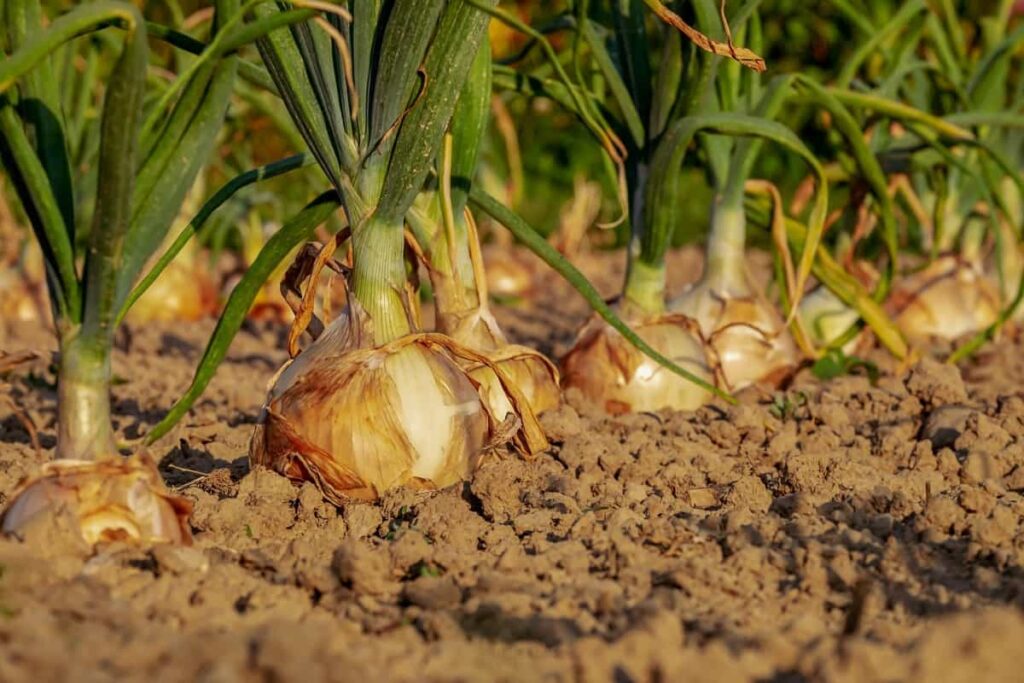
Pusa Ratna
They develop an attractive deep red color when mature and are large, slightly oblate, and exposed above ground. The acuteness of these products is low, and they have good storage quality. This plant has dark green leaves with waxy blooms and reaches a height of about 30 cm. Despite its early maturity, it produces high yields. A hectare of this crop yields approximately 18 tons. A bulb measures 3 cm in length and 6 cm in breadth.
Arka Kalyan
The crop matures in about 140 days and yields about 28 tons per hectare when grown as a Kharif crop. A bulb weighs between 100 and 190 grams, measures about 6.5 cm long, and measures 7.5 cm wide. The bulb is deep pink colored. Purple blotch is less likely to affect the leaves.
Arka Lalima
A high-yielding F1 hybrid type, it produces a high yield. It produces medium to big-sized globe-shaped bulbs with a firm texture and bright red to dark red color. This variety weighs approximately 120 to 130 grams per bulb. This variety has a long shelf life of about four to five months, and this onion type can be transported long distances. In both Kharif and Rabi, this onion variety is suitable for cultivation. Approximately 130 to 140 days after transplanting, this type is mature and ready for harvest. On average, 47 tons of onions per hectare are produced from this onion type.
Pusa Madhavi
It is a variety of onions released by the Indian Agricultural Research Institute, New Delhi. These onion bulbs have a medium to large size, are light red, and have a flattish round shape. Good keeping qualities make it a good choice. It takes 130 to 145 days for the plant to reach maturity after transplanting. This onion type has an average yield potential of 30 tonnes per hectare. For Rabi season and export, it is recommended.
N2-4-1
It is a hybrid onion variety that NIPHAD released. The bulb measures about 4 to 6 cm in diameter, is brick red, has a spherical shape, and has a spicy taste. After transplanting, plants reach maturity in 140 to 145 days. There are about 12% to 13% soluble solids in it. Onion types of this type produce an average yield of 30 to 35 tons per hectare and are suitable for export.
Agrifound Dark Red
A moderate intensity, the spherical, dark red bulb has tight, tight-skinned skin. This variety takes 95 to 110 days to reach maturity after transplantation. Over the country, it is recommended to grow this plant during the Kharif season. On average, this onion variety yields 30 tons per hectare, with 12% total soluble solids and 13% to 14% dry matter.
Agrifound Rose
Bulbs are flattish, round in shape, and deep scarlet red. The plants mature between 95 and 110 days after sowing. Onion varieties in this variety are small, measuring 2.5 to 3.5 cm, and pickling types. It contains 16% to 18% soluble solids and 17% to 19% dry matter. Onions of this type produce 25 to 30 tons per hectare. This plant is recommended for growing in Kharif in Andhra Pradesh and all three seasons in Karnataka.
B. White Onion varieties
Bhima Shweta
The white Onion variety for Rabi is recommended to be released in Chhattisgarh, Gujarat, Karnataka, Madhya Pradesh, Maharashtra, Odisha, Rajasthan, and Tamil Nadu in Kharif. In 110-120 days after transplanting, it reaches maturity. This product has a medium-keeping quality and can be stored for up to three months. In Kharif, the average marketable yield is 18-20 tons per hectare, and in Rabi, 26-30 tons per hectare.
In case you missed it: High Yield Hybrid Tomato Varieties in India: For Winter, Summer, and Rainy Season
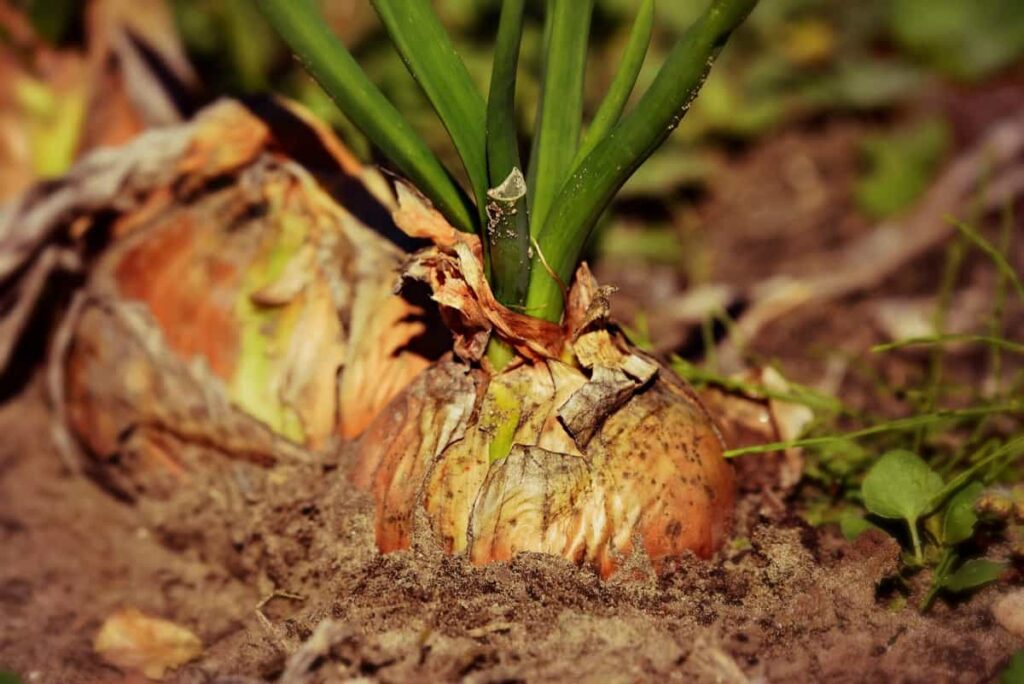
Bhima Shubhra
This white onion variety is recommended for the Kharif season for Chhattisgarh, Gujarat, Karnataka, Madhya Pradesh, Maharashtra, Odisha, Rajasthan, and Tamil Nadu. In Maharashtra, it is also recommended for late Kharif. When transplanted during Kharif, it takes 110 to 115 days to mature; in late Kharif, it takes 120 to 130 days. As a medium storer, it is capable of enduring environmental fluctuations. In Kharif, the average marketable yield is 18 to 20 tons per hectare, and in late Kharif, 36 to 42 tons per hectare.
Bhima Safed
NRCWO-3, also known as Bhima Safed, is suitable for cultivation in Chhatisgarh, Gujarat, Karnataka, Madhya Pradesh, Maharashtra, Orissa, Rajasthan, and Tamil Nadu. This variety matures in 110 to 120 days and has white, round to oval bulbs weighing 70 to 80 grams. It has 11% to 12% total soluble solids and is thus suitable for table and processing. Multilocational trials in the recommended zones yielded 19 tons per hectare on average. There are fewer than 5% doubles and bolters in the crop.
Pusa white flat
It is suitable for cultivation in UP, Bihar, Punjab, Rajasthan, Gujarat, Haryana, and Maharashtra. IARI, New Delhi, developed it. The bulbs produced by this variety are medium to large and contain 12% to 14% total soluble solids. After transplanting, this onion variety matures in 120-130 days. This onion variety yields 30 tons per hectare on average.
Agrifound White
The bulbs are spherical, have tight skin, and are silvery white. Onions of this type mature in 110 to 130 days after transplanting and have a good keeping quality. This variety can be cultivated in the late Kharif and Rabi seasons. It is a good variety for dehydration. A good choice for Maharashtra, Madhya Pradesh, and Gujarat. The total soluble solids are between 14% and 15%, while the dry matter is between 15% and 16%. A hectare of this variety yields 28 to 30 tons on average.
C. Spanish Brown Onion varieties
Bhima Light Red
This onion variety is recommended for the Rabi season in Karnataka and Tamil Nadu. This variety matures in 115 days after transplanting and has light red globe bulbs weighing about 70 grams, a thin neck, and 13% soluble solids. On average, a multi-location trial in the recommended zone yielded 38 tons per hectare. Almost no doubles or bolters are present.
In case you missed it: Seed Germination Chart in India: Duration and Temperature for Fruits, Vegetables, Flowers, and Herbs
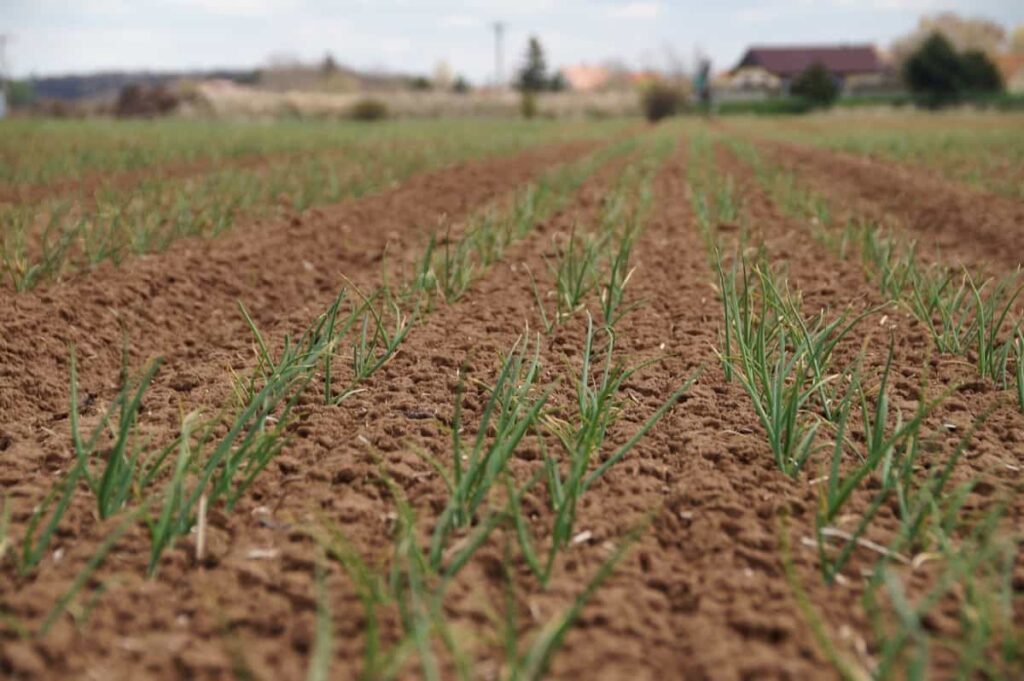
Arka Niketan
A hectare of this crop matures in about 45 days and yields about 24 tons. Mostly, it is a Kharif crop. Bulb necks are rounded and of attractive color. Bulb lengths average 6.5 cm, breadths measure 6 cm, and each bulb weighs about 100 to 180 grams. It is possible to store the bulbs at room temperature for about five months. There is a high amount of dry matter in it.
Onion cultivating seasons in India
Onions are cultivated in almost all states of India as both Kharif and Rabi crops according to their geographical location and weather conditions.
| Seasons | Time of sowing | Time of Transplanting | Time of Harvesting |
| Maharashtra and some parts of Gujrat | |||
| 1. Early Kharif | May – Jun | Jul – Aug | Sep – Dec |
| 2. Kharif | Aug – Sep | Sep – Oct | Jan – Mar |
| 3. Rabi | Oct – Nov | Dec – Jan | Apr – May |
| Tamil Nadu/Karnataka/A.P. | |||
| 1. Early Kharif | Mar – Apr | Apr – May | Jul – Aug |
| 2. Kharif | May – Jun | Jul – Aug | Oct – Nov |
| 3. Rabi | Sep – Oct | Nov – Dec | Mar – Apr |
| Rajasthan/Haryana/Punjab/Uttar Pradesh and Bihar | |||
| 1. Kharif | May – Jun | Jul – Aug | Nov – Dec |
| 2. Rabi | Oct – Nov | Dec – Jan | May – Jun |
| West Bengal and Orissa | |||
| 1. Kharif | Jun – Jul | Aug – Sep | Nov – Dec |
| 2. Late Kharif | Aug – Sep | Oct – Dec | Feb – Mar |
| Hills | |||
| 1. Rabi | Sep – Oct | Oct – Nov | Jun – Jul |
In case you missed it: 21 Profitable Fruit Crops in India: Low-investment and High-returns
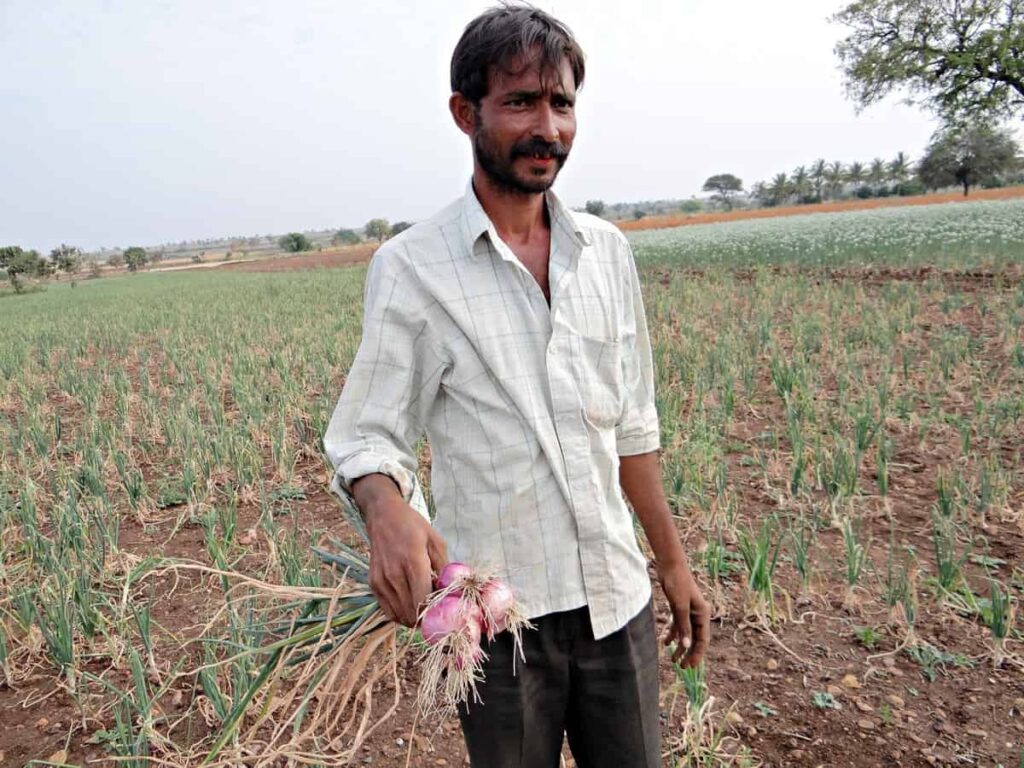
Harvesting Onion crop
Depending on the purpose for which onions are planted, onions are harvested. The onion crop is ready for harvest in five months for dry onions. It takes the crop three months from transplanting to become ready for marketing as a green onion. Onions develop their bulbs from leaf bases, then their leafy green tops become yellow and collapse slightly above the top of the bulb, leaving an upright short neck. When the tops “go down” like this, the bulbs are ready to be harvested.
Commercial growers harvest onions when half the tops have gone down since all the onions do not mature simultaneously. Since tops don’t fall during the Kharif season, bulbs are harvested after leaves turn slightly yellow and red pigment develops on bulbs. When 50% of the tops of rabi onions have collapsed, it is best to harvest them one week later. After the tops of onions have started to fall over, they should be harvested for use as dried bulbs or storage.
Onion bulbs are typically formed at the soil surface, so pulling mature bulbs by hand is sometimes possible. Whenever hand pulling is impossible, the crop is harvested by loosening the bulbs with a fork or hoe before lifting them. The harvested crop is left in windrows in the field for a few days until it dries. After the leaves have completely dried, they are cut about 2 to 2.5 cm above the bulb. In this way, the dry matter content can be increased. When tops are cut too close, the neck is not sealed well, allowing decay bacteria to enter.
Conclusion
India has recently had a shortage of onions, leading to price increases. Onion cultivation is, therefore, an agribusiness that can be highly profitable. If you plan to cultivate Onions, choose the best variety suitable for your local climatic conditions and follow the recommended practices for growing for better yields. If you live in the following states or regions and plan to grow onions, this blog post would help you learn about Hybrid High Yield Onions Varieties in India.
| Andhra Pradesh | Karnataka |
| Arunachal Pradesh | Kerala |
| Assam | Madhya Pradesh |
| Bihar | Maharashtra |
| Chhattisgarh | Manipur |
| Goa | Meghalaya |
| Gujarat | Mizoram |
| Central India | South India |
| Haryana | Sikkim |
| Himachal Pradesh | Tamil Nadu |
| Jharkhand | Telangana |
| Nagaland | Tripura |
| Odisha | Uttar Pradesh |
| Punjab | Uttarakhand |
| Rajasthan | West Bengal |
| North India | West India |
- Management Pests and Diseases in Your Cotton Field
- Sheep Farming Business Plan for Beginners
- Aquaponic Farming at Home: A Step-By-Step Guide
- Profitable Village Farming Business Ideas in 2024
- High-Yield Aquaculture: Fast-Growing Fish for Farming
- Effective Fish Pond Construction Techniques for Beginners
- Irrigation and Water Management in Pineapple Farming
- Blossom to Harvest: Mastering Flowering and Pollination in Papaya Farming
- Pig Fattening Essentials: From Selection to Sale for Beginners
- Raising Wagyu Cattle: A Complete Guide for Premium Beef Production
- Soil Types and Their Water Holding Capacity
- Optimizing Irrigation Schedules for Coconut Groves for Enhanced Yield
- Espresso Your Garden: Coffee Grounds for Healthier Acid-Loving Plants
- The Best Soil Mix for Snake Plants: How to Mix Your Own Snake Plant Soil
- Green Thumb Success: Expert Tips for Cultivating Greenhouse Beans All Year Round
- Bloom All Year Round: The Ultimate Guide to Indoor Hyacinth Care
- Eco-Friendly Gardening: How to Make Liquid Fertilizer from Kitchen Waste
- Ultimate Guide to Grow Anise in Pots: Explore Seed Propagation to Harvesting
- Guide to Raising Chester White Pigs: Discover Breed Facts to Growth Management
- Mastering the Elegance: The Ultimate Guide to Weeping Cherry Tree Care, Planting, and Maintenance
- Ultimate Guide to Planting Garlic in Grow Bags: Growing Strategies for Beginners
- How to Fix Spider Plant Leaf-Related Problems: Natural and Organic Remedies
- 10 Reasons Why Your Tulsi Plant is Shedding Leaves: Home Remedies and Solutions
- Optimizing Growth and Yield: The Advantages of Palm Bunch Ash Fertilizer
- Utilizing Neem Oil Extract as a Natural Pesticide for Hydrangea
- From Soil to Harvest: Various Ways in Which Farmers Can Use AI Tools
- Steps to Encourage and Induce Citrus Flowers: A Comprehensive Guide
- How to Fix Snake Plant Leaf-Related Issues: Natural and Organic Remedies
- Transform Your Garden into a Fragrant Oasis with Raat Ki Rani (Night Blooming Jasmine)
- Discover the Ideal Chicken Breeds for Philippine Farms
- How to Create a Poultry Egg Farm Business Plan for Profits
- Grow Lemon Cucumbers Like a Pro: Insider Techniques for Bountiful Yields
- Ultimate Guide to Caring for Your Pink Princess Philodendron: Tips for Thriving Variegation
- Areca Nut Profit Per Acre: Calculating Yield and Cost of Cultivation
- How Kaveri Chicken is Becoming a More Profitable Breed in Indian Backyards
- Transform Your Barn: 9 Steps to Convert a Horse Stall into a Chicken Coop
